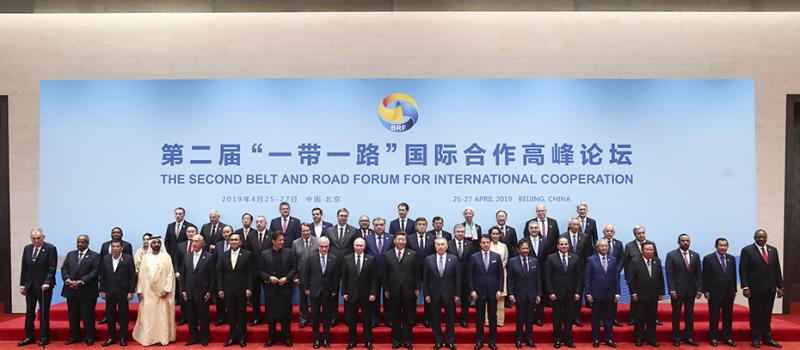ESG sustainability is the key to BRI’s success
posted by Xi Sun on May 13, 2019 - 8:41am

By SUN Xi and Herta Monica Montesino Cucos
The Belt and Road Initiative (BRI), previously known as the One Belt One Road (OBOR) Initiative, consists primarily of the Silk Road Economic Belt and the 21st-century Maritime Silk Road. The BRI is a grand and ambitious vision initiated by Chinese President Xi Jinping in 2013 aiming to improve regional cooperation and connectivity between Asia, Europe and Africa through a comprehensive network of ports, roads, railways and trading hubs – reviving ancient overland and maritime trade routes.
Currently, the BRI links between China and some 65 other countries that account collectively for over 30 per cent of global GDP, 62 per cent of population, and 75 per cent of known energy reserves. However, along with some other western countries, the US has been sitting out of the BRI since the very beginning, criticizing the BRI’s opaque financing practices, poor governance and disregard for internationally accepted norms and standards.
On April 25th-27th, 2019, China hosted the 2nd Belt and Road Forum for International Cooperation (BRF) in Beijing, where almost 40 foreign leaders and as many as 5,000 representatives from 150 countries took part in, but the US absented. During the forum, Chinese President Xi Jinping pledged to make the BRI clean, green and financially sustainable so as to address international criticism. Easy to say, difficult to do.
To embrace the highest international standards, it may be wise for the BRI to comprehensively integrate the Environmental, Social and Governance (ESG) considerations into its business practices.
On the one hand, Chinese companies participating the BRI, no matter state-owned or private, should fully fulfil its Corporate Social Responsibility (CSR) in their daily operational activities in all ESG aspects, with accountability, transparency, ethical behaviour, as well as respects for stakeholder interests, the rule of law, international norms of behaviour and human rights.
Those companies should adhere to the United Nations (UN) Global Compact’s ten universal principles in the areas of human rights, labour, the environment and anti-corruption, and can follow the guidance on social responsibility (ISO 26000:2010) of the International Organization for Standardization (ISO).
On the other hand, more importantly, the BRI’s key loan and investment vehicles, especially the Asian Infrastructure Investment Bank (AIIB) founded in January 2016 and the Silk Road Fund (SRF) established in December in 2014, can wisely adopt the Socially Responsible Investing (SRI) strategy, which seeks to consider both financial return and ESG good.
The BRI’s main activities, infrastructure developments, generally can cause serious negative impacts on both environment and community. Moreover, infrastructure investments in developing countries usually involve corruption, pollution and human rights abuses. Therefore, the BRI’s success will not only rest on how many projects it can fund, but also how to fund.
The 70-year-old World Bank has accumulated some good practices, such as declining to fund controversial giant dam projects and blacklisting companies found guilty of collusion, corruption, fraud or coercion.
If the brand-new AIIB and SRF want to do better, they have to be more innovative and decisive in integrating ESG facts. They may follow the UN-backed Principles for Responsible Investment (PRI) Initiative, which provides six basic principles for international institutional investors to fulfil fiduciary responsibilities. And they may also refer the Equator Principles (EPs) to manage the environmental and social risks of its lending and investment activities.
Broadly speaking, the AIIB and the SRF together with their clients should comprehensively identify, assess and manage the ESG risks and impacts in a structured way, on an ongoing basis. Meanwhile, they should not provide project finance or project-related corporate loans to projects where the client will not, or is unable to, fulfil its ESG responsibilities.
Concretely speaking, in the Environmental aspect, pollution should be avoided or minimised, and the importance of climate change and biodiversity should be recognised; in the Social aspect, universal human and labour rights should be respected, local communities’ interests should be protected, and the same requirements should be extended to suppliers or contractors; and in the Governance aspect, any form of corruption should be prohibited, and ethical, democratic and transparent business culture should be advocated.
The BRI can be viewed as a touchstone to test China’s global leadership. Its temporary popularity is not the conclusion but just a start of its long and tough journey. The Chinese model of infrastructure development has been widely criticized for ignoring ESG impacts, although it has certain merits of being pragmatic, fast and cost-effective.
Therefore, the key challenge is showing the skeptical western world that this China-led BRI will run differently, professionally and responsibly, while ESG sustainability can be the key to its future success.
This article was c


